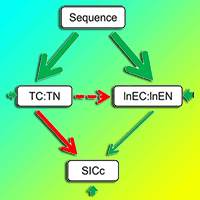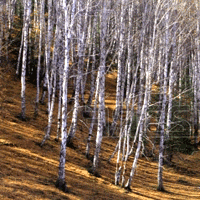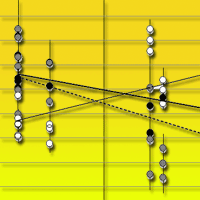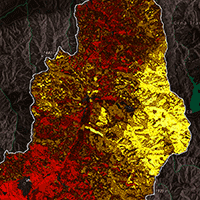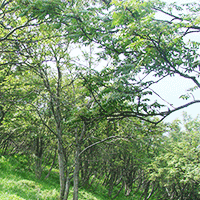
Rapid spread of a fleshy-fruited species in abandoned subalpine meadows - formation of an unusual forest belt in the eastern Carpathians
Tomasz Durak (1) , Magdalena Zywiec (2), Pawel Kapusta (2), Jan Holeksa (3)
iForest - Biogeosciences and Forestry, Volume 9, Issue 2, Pages 337-343 (2015)
doi: https://doi.org/10.3832/ifor1470-008
Published: Nov 20, 2015 - Copyright © 2015 SISEF
Research Articles
Abstract
In recent decades, most subalpine hay meadows and pastures have been abandoned, and trees have been recolonizing these sites where forest existed before agricultural activity. This study examined how woody vegetation, dominated by the deciduous fleshy-fruited tree Sorbus aucuparia (rowan), expanded on subalpine meadows in the Western Bieszczady Mountains (eastern Carpathians, Poland) after the cessation of agricultural use. The aims were to determine the abundance of rowan in the woody vegetation, to estimate the rate of rowan expansion in the studied area, and to characterize the variability of rowan stands and growth forms. Rowan dominated the current plant community of abandoned subalpine meadows, though this species is not considered a rapid colonizer of open areas and was not frequent in the uppermost forest belt before the colonization. The whole area was encroached by rowans in a very short period of time 60-70 years ago. Rowan tree density was similar throughout the elevational gradient but the growth form changed, becoming more shrub-like with increasing elevation. Rowan stands will likely be the main element of the subalpine belt in this region in the upcoming decades. At present, no tree species can be considered a rapid successor to rowan in the area.
Keywords
Abandoned Subalpine Meadows, Forest Recolonization, Land Use Change, Subalpine Forest, Succession of Woody Vegetation
Authors’ Info
Authors’ address
Department of Botany, University of Rzeszów, ul. Zelwerowicza 4, PL-35-601 Rzeszów (Poland)
Pawel Kapusta
Institute of Botany, Polish Academy of Sciences, ul. Lubicz 46, PL-31-512 Kraków (Poland)
Adam Mickiewicz University, Faculty of Biology, Department of Plant Ecology and Environment Protection, ul. Umultowska 89, PL-61-614 Poznan (Poland)
Corresponding author
Paper Info
Citation
Durak T, Zywiec M, Kapusta P, Holeksa J (2015). Rapid spread of a fleshy-fruited species in abandoned subalpine meadows - formation of an unusual forest belt in the eastern Carpathians. iForest 9: 337-343. - doi: 10.3832/ifor1470-008
Academic Editor
Emanuele Lingua
Paper history
Received: Oct 10, 2014
Accepted: Jul 17, 2015
First online: Nov 20, 2015
Publication Date: Apr 26, 2016
Publication Time: 4.20 months
Copyright Information
© SISEF - The Italian Society of Silviculture and Forest Ecology 2015
Open Access
This article is distributed under the terms of the Creative Commons Attribution-Non Commercial 4.0 International (https://creativecommons.org/licenses/by-nc/4.0/), which permits unrestricted use, distribution, and reproduction in any medium, provided you give appropriate credit to the original author(s) and the source, provide a link to the Creative Commons license, and indicate if changes were made.
Web Metrics
Breakdown by View Type
Article Usage
Total Article Views: 49079
(from publication date up to now)
Breakdown by View Type
HTML Page Views: 41256
Abstract Page Views: 2675
PDF Downloads: 3836
Citation/Reference Downloads: 24
XML Downloads: 1288
Web Metrics
Days since publication: 3682
Overall contacts: 49079
Avg. contacts per week: 93.31
Citation Metrics
Article Citations
Article citations are based on data periodically collected from the Clarivate Web of Science web site
(last update: Mar 2025)
(No citations were found up to date. Please come back later)
Publication Metrics
by Dimensions ©
Articles citing this article
List of the papers citing this article based on CrossRef Cited-by.
References
Winter desiccation stress and resting bud viability in relation to high altitude survival in Sorbus aucuparia L. Flora 172: 21-34.
Gscholar
Zespól jarzebiny Athyrio-Sorbetum Ass. nova w strefie górnej granicy lasu masywu Babiej Góry (Beskid Zachodni) [Athyrio-Sorbetum ass. nova in the zone of upper forest limit in the Babia Góra massif (Western Beskidy Mountains)]. Badania Fizjograficzne nad Polska Zachodnia Seria B 36: 116-133. [in Polish]
Gscholar
Woody vegetation in abandoned subalpine meadows of the Western Bieszczady Mts. Acta Biologica Cracoviensia Series Botanica 55 (Suppl. 1): 43.
Gscholar
Rozprzestrzenianie sie drzewiastych zarosli w pietrze polonin Bieszczad Zachodnich [Expansion of brushwood in the subalpine zone of the Western Bieszczady Mts.]. Sylwan 157: 130-138. [in Polish]
Gscholar
Spatial pattern of a pioneer tree seedling bank in old-growth European subalpine spruce forest. Ekológia 24: 263-276.
Gscholar
Zycie pasterskie w Beskidach Wschodnich [Pastoral life in the Eastern Beskidy Mountains]. Prace Instytutu Geograficznego UJ 5, Kraków, Poland, pp. 138. [in Polish]
Gscholar
The upper forest limit dynamics in the Western Bieszczady Mts. - changes over a century and a half. Studia Naturae 54 (2): 33-156.
Gscholar
The upper forest limit within the villages of Ustrzyki Górne and Wolosate (Bieszczady Mts.) in the end of eighteenth century. Roczniki Bieszczadzkie 20: 15-27.
Gscholar
Zmiany przebiegu górnej granicy lasu w pasmie Szerokiego Wierchu w Bieszczadzkim Parku Narodowym [Changes of upper forest limit in the Szeroki Wierch range (Bieszczady National Park)]. Roczniki Bieszczadzkie 12: 81-102. [in Polish]
Gscholar
Zespoly lesne Polski [Forest associations of Poland]. PWN, Warszawa, Poland, pp. 357. [in Polish]
Gscholar
Zbiorowiska lesne Bieszczadzkiego Parku Narodowego [Forest plant communities of the Bieszczady National Park]. Monografie Bieszczadzkie 1: 1-175. [in Polish]
Gscholar
Flowering plants and pteridophytes of Poland. A checklist. W. Szafer Institute of Botany, Polish Academy of Sciences, Kraków, Poland, pp. 441.
Gscholar
Vegetation-environment relationships of boreal spruce swamp forests in Ostmarka Nature Reserve, SE Norway. Sommerfeltia 29: 1-190.
Gscholar
Laki i pastwiska w Bieszczadach Zachodnich [Meadows and pastures in the West Bieszczady mountains]. Studia geobotaniczno-gospodarcze, Roczniki Nauk Rolniczych, Ser. D - Monografie 99-D, PWRiL, Warszawa, Poland, pp. 128. [in Polish]
Gscholar
Scrub communities dominated by Sorbus species in the subalpine zone of the Monts du Fez (Massif Central, France). Proceedings of the Konginklijke Nederlandse Akademie van Wetenschappen. Biological, Chemical, Geological, Physical and Medical Sciences 95: 473-495.
Online | Gscholar
Lasy i zwierzyna Gór Sanockich [Forests and wild game of the Sanockie mountains]. PWN, Poznan, Poland, pp. 113. [in Polish]
Gscholar
Gleby Bieszczadzkiego Parku Narodowego [Soils of the Bieszczady National Park]. Monografie Bieszczadzkie 2, Bieszczadzki Park Narodowy, Ustrzyki Dolne, Poland, pp. 88. [in Polish]
Gscholar
Plant communities with Pinus mugo (alliance Pinion Mugo) in the subalpine belt of the Western Carpathians - a numerical approach. Acta Societatis Botanicorum Poloniae 74 (4): 329-343.
Gscholar
Zbiorowiska roslinne polonin Bieszczadzkiego Parku Narodowego (Bieszczady Zachodnie, Karpaty Wschodnie) [Plant communities of subalpine meadows (poloninas) in the Bieszczady National Park (Western Bieszczady Mts, Eastern Carpathians)]. Monografie Bieszczadzkie 4, Bieszczadzki Park Narodowy, Ustrzyki Dolne, Poland, pp. 215. [in Polish]
Gscholar
Lasy Bieszczadów Zachodnich [The forests of the Western Bieszczady Mts.]. Acta Agraria et Silvestria Seria Lesna 3: 3-132. [in Polish]
Gscholar
On the ecology of Sorbus aucuparia (Rosaceae) with special regard to germination, establishment and growth. Polish Botanical Journal 46 (2): 229-239.
Gscholar
The growth rate of rowan (Sorbus aucuparia L.) versus subalpine spruce stand breakdown. Sylwan 4: 38-45.
Gscholar



